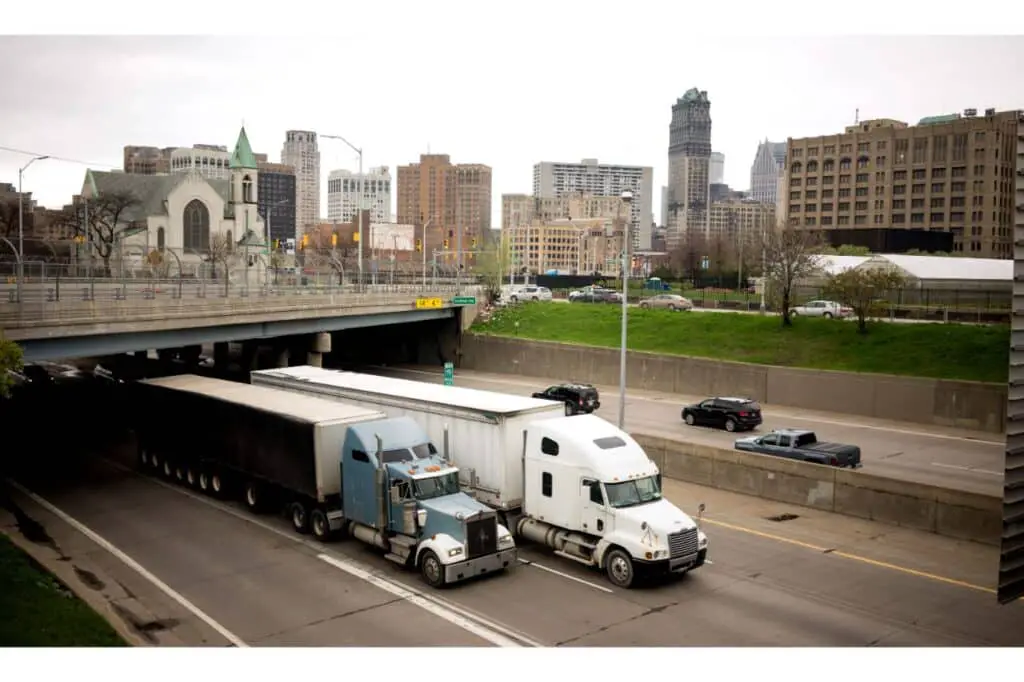Are you on the hunt for railroad jobs in Michigan?
Well, you’re in luck. It’s a thriving rail-rich state, you’re spoiled for choice.
The Great Lakes State is home to four of the seven big class I railroads. These are Norfolk Southern, CSX, Canadian Pacific, and Canadian National.

“Michigan Services” from Amtrak also link several locations to Chicago.
And apart from these, there are two Class II regionals in Michigan. This includes the Great Lakes Central and the Indiana and Ohio Railway.
Finally, the state boasts a great amount of Class III shortlines. Therefore, you’ve got a whole lot of choices for finding a decent railroad job in the state
All in all, Michigan holds a total of 3,600 miles of trackage!
Michigan’s rails transport around 17% of its freight volume and 21% of value-added goods.
Additionally, three intercity passenger rail lines are supported by this system.
Ultimately, the state has a pretty well-developed rail network. It supports the economic development within the state and the Detroit Aerotropolis Region.
Another thing that Michigan rails are known for is its solid railroad history.
Its been around for more than 170 years now. Throughout its course, Michigans rail system is known for hauling a wide range of goods.
These include iron, lumber, automobile components and accessories, and more. Michigan also holds a great geographical advantage near Ludington.
Overall, Michigan is a great state to work for rail-wise. If you land a railroad job in this state, consider yourself lucky as there will be plenty of opportunities to grow and advance!
Job-hunting can be challenging, especially if you don’t know where to look.
So, we’ve laid down everything you need to know — all in one place.
In this post, we outline all the railroad companies you can apply for in Michigan.
Before that, we talk briefly anout the economic value of Michigan’s rails. And finally, we add in some useful tips for fresh railroaders.
Let’s get started!
Railroads in Michigan: Economic Importance
Let’s take a look at the figures. According to 2018 data, freight railways generated over 219 billion dollars in economic value.
Alongside that, it earns approximately 26 billion dollars in tax revenue. Michigan’s railway system transports roughly $194 billion in goods yearly.
Moreover, railway lines support Canadian commerce too. The biggest trading connection in the world is between the United States and Canada.
When it comes to exports, Michigan is the top-ranking state for Canadian trade. In fact, the state exported nearly 24 billion dollars worth of products in 2017.

Railroads alleviate highway traffic congestion we all know that.
Michigan is one of our states that experience heavy traffic. Traffic can lower productivity, boost operating expenses, and drops the fuel economy.
In fact, the trucking business was predicted to lose about 500 billion in 2015 due to delays.
Michigan’s railroads greatly help with these chokepoints. Apart from reducing traffic, it saves taxpayer money, since most networks are privately maintained.
Furthermore, roughly two-thirds of the state’s freight is transported by rail.
The other transportation options are vehicles (which account for 65% of freight). There is also water transportation (14%) and air transport (1%).
Roads are the most frequent means of freight transportation. However, rails are predicted to climb by 50% in 2030.
Trains are more environmentally friendly, too. It emits fewer gas emissions and can haul more items than trucks.
Finally, the railroad is a job-generating sector. There were over 2,812 freight rail employees in 2019. The sector continues to offer competitive salaries and impeccable employee benefits.
Overall, railroads hold unique economic benefits that other modes of transport don’t.
So, working in this sector can be fulfilling. But, there are a few things you need to know if you’re freshly coming into the sector.
Working For The Railroad: What It’s Like and Factors You Need To Consider
It’s a smart idea to grasp what it’s like working for the railroad. The truth is that railroading is not for everyone.
The concept of railroading is generally portrayed as exciting, adventurous, and sometimes fun. This is true in many cases.
But, some seem to glorify or overstate the positives of railroading. The reality is, it can be a damn hard job!
Working for the railroad can be mentally AND physically grueling.
Class I railroads typically require 12-hour daily shifts for workers.
Plus, you can get relocated or placed in another post, if necessary.
Because of this, you will be spending a lot of time apart from family. This is mostly why it’s such a well-respected career.

But, on the brighter side, Class Is are among the best-paying jobs in the industry.
Apart from the good wage, class I companies offer generous perks and pension plans.
You can find predictable and fixed schedules with short lines and regionals. But then again, their wages don’t match with Class I jobs.
On average, a railroader in Michigan earns $48,000. Wages vary according to skills, education, and experience.
It’s actually not uncommon to earn 6 digits after years of working.
These are usually the deal breakers for potential railroaders. So, keep these in mind. In the end, it’s up to you.
Do the pros weigh out the challenges? Can you work away from family all the time?
If you’re still a student, you can check out internships.
Usually, Class Is offers summer programs for prospective railroaders. This way, you get to experience the industry first-hand.
You’ll also get to see what kind of job on the railroad suits you, if you get the opportunity, I totally recommend this.
So, without further ado, let’s get into your options for railroad jobs in Michigan!
Class I Railroad Jobs in Michigan
Canadian National
The Canadian National is among the seven main Class I railroads in the country. It’s also one of the two major networks in Canada.
Canadian National covers its whole nation from end to end. Additionally, it serves the Midwest and Gulf Coasts of the United States.
The network was initially a government-owned railway at first.
Back then, its main purpose was to combine abandoned and defunct lines. However, it grew as one of the main networks in the country.
It eventually became privately owned in 1995. And today, it offers a wide array of services and hauls many products.
Overall, Canadian National operates roughly 20,4000 miles of trackage. Learn more about the company by clicking here.
CSX Transportation
This Class I network also goes by CSX or CSXT. CSX Corporation’s railroading division owns and operates this business.
Moreover, they’ve been in business since the 1980s.
The network was formed from a merger of two lines. This includes the Seaboard Coast Line and Chessie System.
They only began as a holding corporation. But as its subsidiaries grew, so did the whole network.
It also acquired 50% of Conrail’s system in 1999. And in late 2022, they purchased Pam Am Railways. It expanded its service area throughout most of New England.
CSX ranks third of all Class I railroads in America.
In total, their network holds 21,000 miles or 34,000km of trackage. Learn more about working for CSX by clicking here.
Norfolk Southern
This Class I network is eastern America’s second-biggest network.
They are also well-known for their robust and stable management. A large part of today’s Norfolk Southern was formed from a merger in the 1980s.
This involves Norfolk and Western and the Southern Railway. Likewise, these two businesses were well regarded because of their long histories of solid administration and effective operations.
All in all, Norfolk Southern operates 28,400 miles of trackage. Other companies run some trackage rights of these miles too.
Learn more about Norfolk Southern by clicking here.
Canadian Pacific Railway
CP Railway was the earliest and first transcontinental railway in Canada.
Unlike Canadia National, CP was not and still isn’t government-owned.
But even so, the government assisted in its early development.
They are privately owned by Canadian Pacific Railway Limited. In total, the company operates 20,100 miles of trackage.
Its routes serve seven Canadian provinces and the United States.
Interested in the Canadian Pacific Railway? Learn more about working for them by clicking here.

Class II Railroad Jobs in Michigan
Great Lakes Central Railroad
GLC (Great Lakes Central Railroad) is a Class II regional railroad.
Back in the day, they were known as the Tuscola and Saginaw Bay Railway (TSBY).
This railway was formally established in the 1970s. Its routes ran from Millington, Munger, Vassar, and Colling.
Today, Federated Railways, Inc. owns the company. Overall, this regional railroad runs 400 miles of trackage.
This makes it the biggest class II in Michigan.
Learn more about the company by clicking here.
Indiana and Ohio Railway
The IORY is a Genesee & Wyoming-owned railroad. It hauls a wide variety of products.
This includes lumber, metal, chemicals, and grain. Overall, this class II railroad operates 570 miles of trackage.
Its routes also serve Ohio, South of Michigan, and southeastern Indiana.
Learn more about them by clicking here.
Class III Shortline, Terminal, and Switching Railroad Jobs in Michigan
Adrian and Blissfield Rail Road, Detroit Connecting Railroad, and Charlotte Southern Railroad
All three lines belong to the same company.
For the last 25 years, they’ve been running five unconnected lines throughout Michigan.
The railroad’s Old Road Dinner Train is also something is known for.
Overall, they operate 20 miles of trackage.
Get in touch with them through their website. Click here.
Ann Arbor Railroad
This class III railroad dates back to the 1890s. It’s shaped by the rearrangement of transportation lines.
This includes networks from Toledo, Frankford, and Ohio. The Ann Arbor Railroad or AA is now a G&W-owned property.
In total, they operate 86.5 miles of trackage with a 286 track capacity.
Learn more about them by clicking here.
Delray Connecting Railroad
This class III shortline, reporting as “DC” operates in Zug Island.
It also services the steel mill of the Great Lakes Works. Additionally, they do interchanges with Class I Canadian National.
Currently, Transtar owns the company and operates 15.64 miles of trackage. Learn more by clicking here.
Escanaba and Lake Superior Railroad
This venerable, privately-owned railroad commenced in the 1890s.
During this time, it mainly served the Upper Peninsula’s forestry needs. Its tracks progressively developed to 65 miles of trackage.
Natural rocks were also added to its roster of freight. Today, the ELS runs 347 miles of trackage. Its routes cover Wisconsin and still the Upper Peninsula.
208 of its miles also travel to Rockland and Green Bay.
This shortline also offers various services.
This includes railcar storage, contract repairs, maintenance, and more. Learn more about them by clicking here.
Grand Rapids Eastern Railroad
The Grand Rapids Eastern Railroad (or GR) runs east to west.
Its routes service Grand Rapids and Lowell. It also does interchanges with Grand Elk and CSX.
In total, they operate 47 miles of trackage.
GR commenced in 1993 and was acquired by RailAmerica in 2000.
But today, it is a Genesee & Wyoming Inc. property.
It mostly hauls lumber, grain, and sodium carbonate.
Learn more about them through G&W’S website. Click here.

Grand Elk Railroad
This class III railroad is another Watco-owned shortline.
It’s also a relatively new railroad that commenced in 2009. The Grand Elk Railroad is one of Michigan’s larger shortlines.
Overall, they operate 122.9 miles of trackage. Its routes run south.
The locations include Grand Rapids, Kalamazoo, and Indiana.
The company also connects three large railways and shortlines together. These include:
- CSX – Grand Rapids
- Norfolk Southern – Elkhart and Kalamazoo
- Canadian National – Kalamazoo
- Marquette Rail – Grand Rapids
- Grand Rapids Eastern Railroad – Grand Rapids
- Michigan Southern Railroad – White Pigeon
Learn more about them through the Watco website. Click here.
Huron and Eastern Railway
Another Genesee & Wyoming-owned shortline is the Huron and Eastern Railway.
This commenced in the 1980s. Back then, it ran through the old Chesapeake and Ohio Railway.
Today, it operates nearly 400 miles of trackage. Learn more about them through G&W’S website. Click here.
Indiana Northeastern Railroad
The origins of this shortline began in the 1990s.
Currently, the Indiana Northeastern Railroad operates 120 miles of trackage.
It primarily serves Northeastern Indiana, Northwestern Ohio, and Southern Michigan.
Contact the company by clicking here.
Lake State Railway
This class III shortline mainly hails limestone and aggregate. It also carries some coal, chemicals, and grains.
Lake State Railway serves a number of renowned companies too. This includes:
- Dow Chemical Company
- Lafarge,
- S. C. Johnson & Son,
- Archer Daniels Midland
- ConAgra Foods
- Consumers Energy
- Conrad Yelvington Distributors
In total, Lake State operates 375 miles of trackage.
Lake Superior and Ishpeming Railroad
The LSI commenced in the 1890s. At its pinnacle, it covered almost 200 miles of trackage.
Today, it operates only 16 miles of it. Its route runs from Empire Tilden Mine and Ishpeming, hence its name.
Begin Your Railroading Career With These Railroad Jobs in Michigan!
Railroad jobs in Michigan are plenty as we say. The state has four Class Is, two regionals, and many shortlines.
Therefore, your chances of getting a job are higher here and your potential career progression is solid too!
Again, railroad work isn’t for everyone. So, we highly suggest you do your research before entering the field.
Nevertheless, there are a wide array of jobs suited for your experiences.
Job-hunting won’t always come easy. This is especially true if you’re aiming for a specific position.
But, don’t let this discourage you.
If you really want to be a railroader, don’t give up. And once you get the job, you’re just getting started.
Railroading will surprise you with many benefits — as long as you work hard.
Are you still widening your options?
We can help with that, too. We’ve got a list of jobs per state.
Check back on our page from time to time for fresh railroad content, too!
This wraps up our list of railroad jobs in Michigan.
Best of luck with your job hunt and railroad career!

